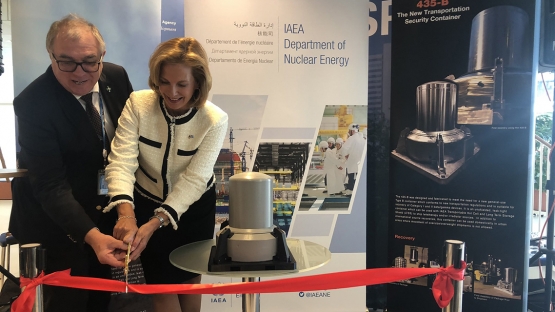The IAEA will now have access to a new container for the transport of disused sealed radioactive sources (DSRS), thanks to a contribution from the U.S. Department of Energy’s National Nuclear Security Administration (DOE/NNSA). The contribution was announced during a ceremony at last week’s 63rd IAEA General Conference.
The container, a model 435-B Type B(U), was designed for domestic and international transport of many types of radioactive sources and devices. It is certified to transport both very high activity sources such as teletherapy sources and irradiators, as well as sources with somewhat less activity such as those used for industrial gamma radiography and high or medium dose rate brachytherapy.
The container’s delivery was marked by a ribbon-cutting ceremony at the IAEA’s Vienna headquarters.
“One of the major expenses associated with source removals from a Member State is the transport cost as well as the leasing of an authorized transport container,” said Mikhail Chudakov, IAEA Deputy Director General and Head of the Department of Nuclear Energy. “As the IAEA will now have direct access to a licensed container, we will be able to provide a more effective method for the safe and secure transport of DSRS from users’ premises to an authorized recipient for further management.”
Radioactive sources, which are used for a variety of applications in areas such as medicine, industry, research and agriculture, must be managed properly not only while they are in use but also once they reach the end of their useful life. This usually involves transport to a location from their place of use.
DSRS management options include interim and long-term storage, recycling, repatriation and final disposal. Transport is also an important step in DSRS management. For the removal of these sources from a country to an authorized facility, they must be properly transported.
“The IAEA having access to this certified shipping container will facilitate their support to ensure the safe and secure management of our DSRS,” said Marinko Zeljko, Director of the State Regulatory Agency for Radiation and Nuclear Safety in Bosnia and Herzegovina.
Transportation of these sources for end-of-life management has been a challenge in many countries due to a lack of suitable containers specially licensed for the transport of DSRS. With this 435-B container now available, the IAEA can assist organizations in charge to more efficiently transport old DSRS.
“Making the 435-B container available further strengthens the cooperation between the United States and the IAEA, and I hope it is taken as a symbol of our long-term commitment to the Agency’s efforts to advance the proper end-of-life management of radioactive sources,” said DOE Under Secretary for Nuclear Security and NNSA Administrator Lisa E. Gordon-Hagerty. “These efforts will not only strengthen global security but will also promote public health and safety.”
Since 2014, the IAEA has supported the removal of more than 60 high-activity DSRS from over 15 Member States. Numerous missions for the consolidation and conditioning of lower activity DSRS have resulted in thousands of DSRS being placed in safe and secure storage. In 2018, the IAEA helped five South American countries remove 27 DSRS in what was the largest such project ever facilitated by the IAEA.





